JAMES BOND
|
||
|
||
JAMES BOND
|
||
|
||
|
||||
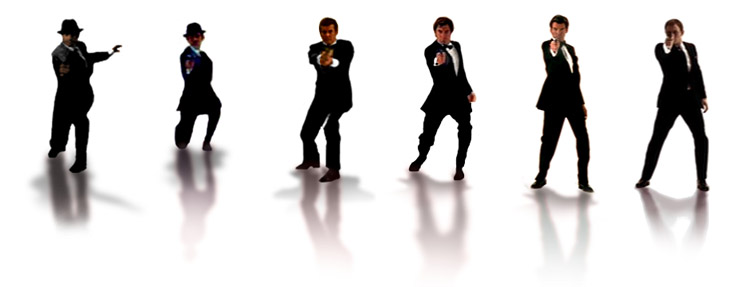 |
||||
|
In 1962 graphic designer Maurice Binder (1918-1991) was hired by producers Harry Saltzman & Albert R. Broccoli to create the main titles for their first James Bond film Dr. No. Along with fellow American designers Saul Bass (1920-1996) and Pablo Ferro (1935-2018), Binder produced title sequences which would ultimately contribute to the mood and theme of the film within the opening moments, often becoming standalone works of art in their own right. Saltzman & Broccoli had seen Binder's work on the 1960 Stanley Donen directed comedy The Grass Is Greener, which was not released in London until March 1961. Rather than just present a list of names of cast and crew as had been the tradition in Hollywood for decades, Binder filmed a special sequence cleverly matching the actions of four babies humorously interacting with the particular credit appearing on screen. The resulting main titles are now better-remembered than the film itself. Maurice Binder had begun his career in advertising in the USA, and had over ten years experience with film publicity and design at Universal and Columbia Studios. His background meant he could provide a visual strategy and design for titles, trailers and print campaigns. |
||||
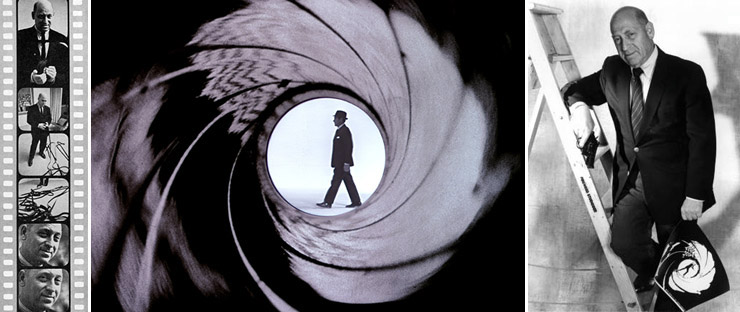 |
||||
|
“Looking down the
barrel of a gun” |
||||
|
||||
|
BOB SIMMONS Dr. No (1962) UK Theatrical trailer created by Maurice Binder |
||||
|
Endlessly parodied since its first appearance, the gun barrel was originally a last-minute invention on the part of Maurice Binder and his assistant, animator Trevor Bond. In a 1983 interview for Starlog magazine Maurice Binder explained how he came up with the idea of the gunshots across the screen by using white price stickers, and then looking down the barrel of a gun as the figure of James Bond walks out and fires directly at the audience. “We had difficulty with the gun barrel,” he admits. “I could not get it in focus. I was working with an animator at the time, and he and I looked down through the camera at the gun barrel. If the front was in focus, the back was out of focus. It did have a nice spiral barrel. We photographed the gun barrel, but we could never get the lens stopped down - f22 is as far as you can stop a still camera down. The animator said, ‘We must stop it down more [to get the whole gun barrel in focus].’ I said, ‘Yeah, what do you use to do it? A pin?’ And he said. ‘As a matter of fact, yes. Why don't we do it?’ So, I grabbed a piece of cardboard, punched a pin-hole in it, put it up to the lens, and the whole gun barrel suddenly came into focus”. The resulting still image is combined with the studio shot footage of ‘James Bond’ walking across the frame and firing his gun (in this instance portrayed by stunt arranger Bob Simmons), and the action combined in an optical printer with an animated blood effect. |
||||
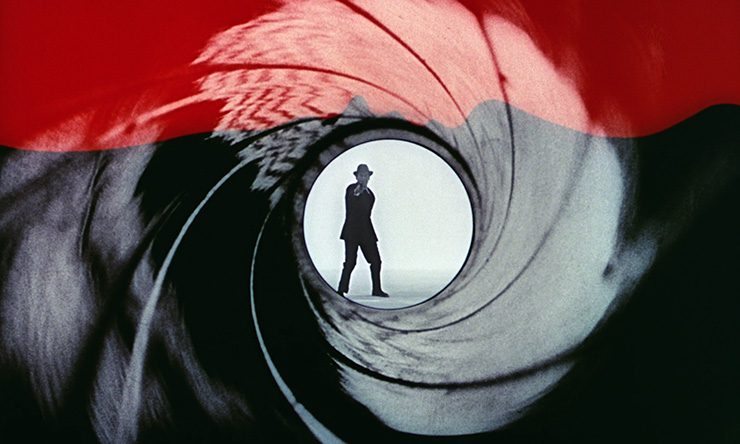 |
||||
|
BOB SIMMONS Dr. No
(1962) [formed part of the main titles] |
||||
|
For the fourth James Bond film Thunderball (1965), Maurice Binder returned as the main title designer and also shot a new gun barrel sequence with Sean Connery. The decision to film Thunderball in the widescreen anamorphic format (with an aspect ratio of 2:35:1) meant that a new sequence needed to be filmed which was then composited with the gun barrel element and animated blood effect shot separately by Maurice Binder. The same footage of Sean Connery was re-used for You Only Live Twice (1967), although this time in black & white, and again for Diamonds Are Forever (1971) incorporating the swirling prismatic effect created by Binder for On Her Majesty's Secret Service (1969). |
||||
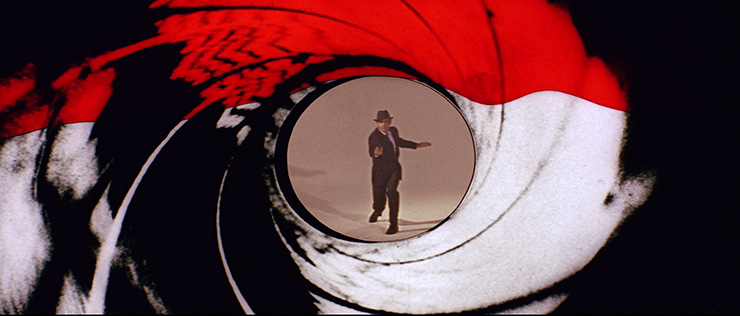 |
||||
|
SEAN CONNERY Thunderball (1965) [colour footage] |
||||
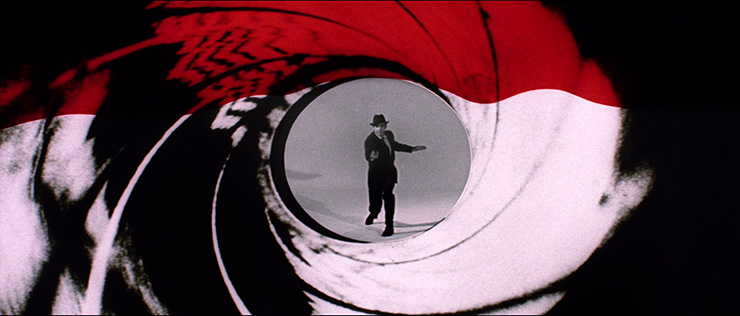 |
||||
|
SEAN CONNERY You Only Live Twice (1967) [b&w footage] |
||||
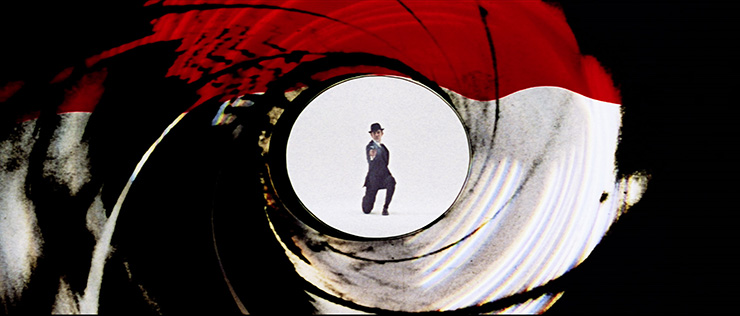 |
||||
|
GEORGE LAZENBY On Her Majesty's Secret Service (1969) [with swirling prismatic effect] |
||||
|
The sixth James Bond film which starred George Lazenby necessitated a new gun barrel sequence to showcase the different actor in the lead role. This was in fact the final piece of footage Lazenby shot for the film. In an effort to remind audiences that On Her Majesty's Secret Service was still part of same series (although George Lazenby had announced this would be his only outing as 007 before the film was even released), Maurice Binder included clips from earlier films into his title sequence, and the gun barrel itself replicated the style of Dr. No (1962), with the white dots pausing to reveal the producer credits before opening up into the gun barrel itself, this time enhanced with a swirling prismatic effect added in the optical printer. The sequence is also unique in that the animated blood obliterates the silhouette of George Lazenby as it pours down the screen. Lazenby was also the only actor to drop to one knee before firing in his gun barrel sequence. |
||||
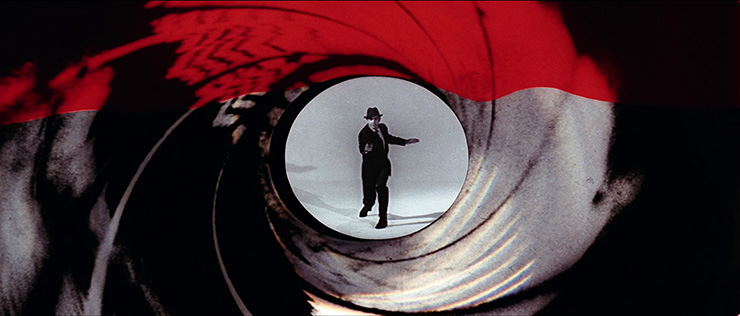 |
||||
|
SEAN CONNERY Diamonds Are Forever (1971) [b&w footage with swirling prismatic effect] |
||||
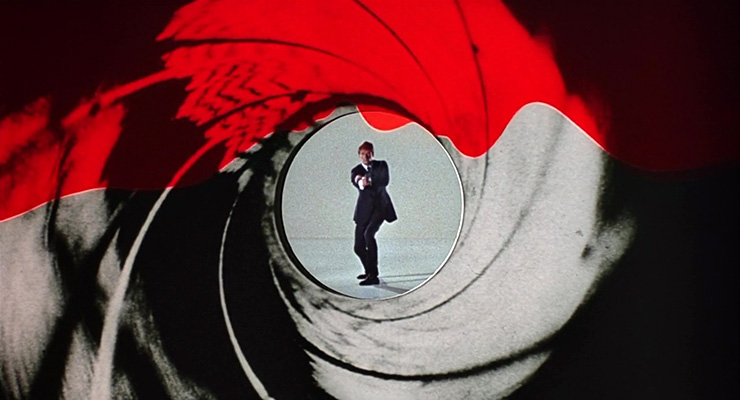 |
||||
|
ROGER MOORE Live And Let Die (1973) and The Man With The Golden Gun (1974) |
||||
|
The first two James Bond films starring Roger Moore returned to the non-widescreen format and utilised Maurice Binder's original gun barrel composited with new with footage of Roger Moore, who was the first actor not seen wearing a hat. Maurice Binder also shot alternate versions of this sequence with Moore walking towards the camera after firing that were used in trailers and TV spots. |
||||
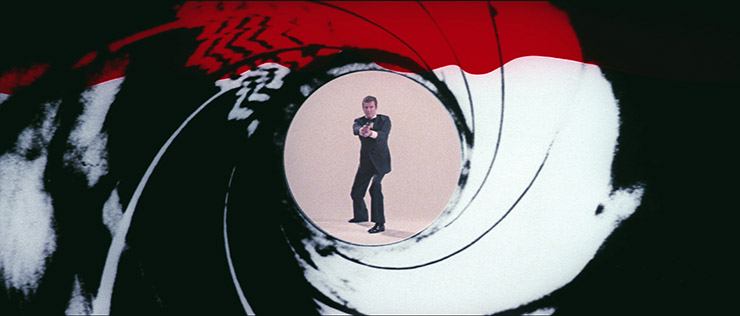 |
||||
|
ROGER MOORE The Spy Who Loved Me (1977), Moonraker (1979), For Your Eyes Only (1981), Octopussy (1983) and A View To A Kill (1985) |
||||
|
Another sequence was filmed with Roger Moore for The Spy Who Loved Me in 1977 when the series returned to the widescreen anamorphic format, and was re-used for the next four films in the series. Maurice Binder also filmed alternate versions used in the teaser trailer for The Spy Who Loved Me (1977) with Roger Moore walking towards camera and addressing the audience (an idea first used in the trailers for Live And Let Die (1973). Presumably this footage was shot at the same time as Roger Moore was being filmed as part of Binder's superb main titles, the first time a Bond actor had appeared in the sequence. |
||||
![TIMOTHY DALTON The Living Daylights (1987) [unused workprint version]](gunbarrels/timothy_dalton3.jpg) |
|
TIMOTHY DALTON The Living Daylights (1987) [unused workprint version] |
|||
|
The casting of Timothy Dalton as James Bond in 1986 saw Maurice Binder film another gun barrel sequence for the opening of The Living Daylights (1987), which again was re-used at the start of Licence To Kill (1989). Binder originally chose a different version of the gun barrel to that seen in the finished film, and this was attached to the workprint version of The Living Daylights, and appeared in a German trailer for the film. In the version seen in the workprint, Dalton clumsily jumps and spins into firing position in an attempt to recreate the original Bob Simmons pose. |
|||
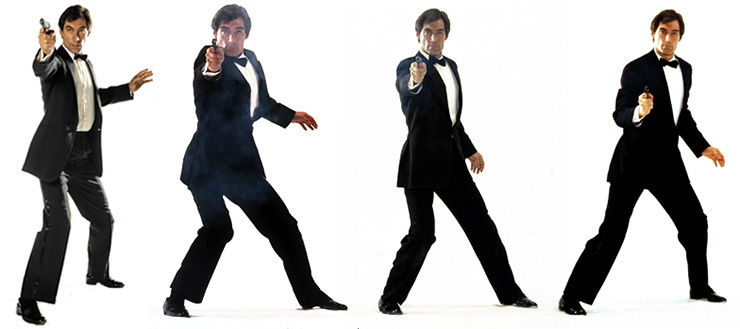 |
|||
|
Timothy Dalton was also captured in a number of Bond-like poses (above) by stills photographer Keith Hamshere as he shot the gunbarrel sequence on December 22, 1986. The same session saw Dalton and Maryam d'Abo pose for a further series of publicity stills, several of which were used as reference material for the poster campaign, and one as the cover of the record sleeve for the vinyl release for The Pretenders ‘If There Was A Man’ 45rpm single and 12" editions. A copy of the unfinished rough assembly of the film containing the alternate gun barrel sequence was stolen from the production whilst the film was still in the editing stage, and low-grade videotape copies circulated in the UK. Worried that the tapes would damage box-office takings, EON Productions and distributor United Artists produced warning posters which appeared on the London Underground and across the country in the weeks leading up to the world premiere. The gun barrel also became the focus in the film's poster campaign, with a simple blue version used on the alternate style-B UK quad-crown poster, whilst Brian Bysouth's illustrations filled the more colourful general release version. |
|||
|
Maurice Binder also incorporated a different gun barrel motif into teaser trailer for The Living Daylights (1987), but this time used as a graphic device to reveal scenes from the pre-credit sequence of the film with very little dialogue, all set to George Martin's version of ‘The James Bond Theme’ from the Live And Let Die soundtrack. The teaser served as the perfect introduction to the new James Bond and features actress Kell Tyler's own speaking voice (she was dubbed in the final film). |
|||
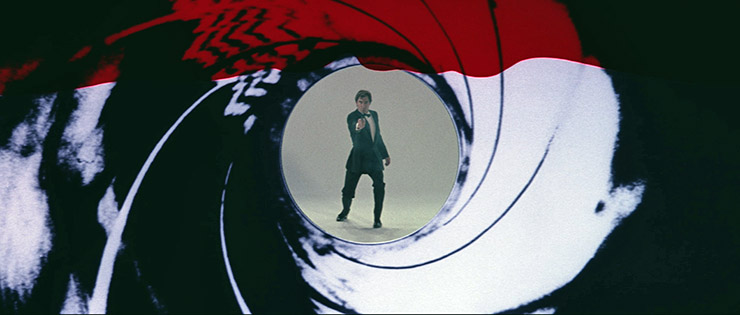 |
|||
|
TIMOTHY DALTON The Living Daylights (1987) |
|||
|
Maurice Binder wisely chose a different gun barrel stance for the final release version of The Living Daylights (1987). The same sequence was re-used at the start of Licence To Kill (1989), although Timothy Dalton is framed slightly closer and off-centre in the finished composite, which used a crisper first generation version of the gun barrel element. The Licence To Kill gun barrel was assembled by Maurice Binder's assistant Alan Church (1964-2024), who also worked on the optical effects seen in the trailers and main titles. |
|||
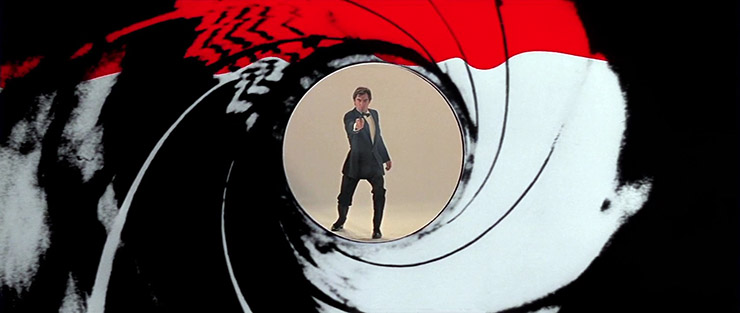 |
|||
|
TIMOTHY DALTON Licence To Kill (1989) [identical footage differently framed] |
|||
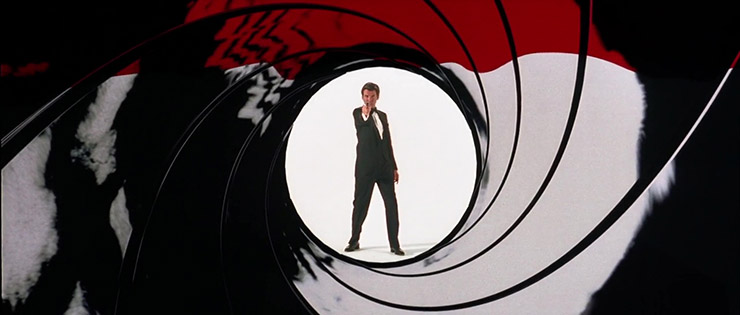 |
|||
|
PIERCE BROSNAN
GoldenEye (1995), Tomorrow Never Dies (1997) |
|||
|
The relatively disappointing box-office returns for Licence To Kill led producer Albert R. Broccoli to question the viability of the series, and in August 1990 put DANJAQ, the company which held the James Bond film copyright, up for sale. Then distributors MGM/UA were having their own financial problems and it took until 1993 for the legal issues to be resolved. Following the death of Maurice Binder in 1991, British television commercial and music video director Daniel Kleinman designed the main titles and gun barrel for GoldenEye (1995). Kleinman had previously directed the music video for Gladys Knight's title song for Licence To Kill. The mid-1990s had seen huge strides in the use of modern technologies (such as computer-generated images) in the filmmaking process. The gun barrel for GoldenEye (1995) was computer generated with moving light and shade variations in the rifling spiral as the weapon tracks Pierce Brosnan across the screen. The same sequence was re-used at the start of Tomorrow Never Dies (1997) and The World Is Not Enough (1999), but for Die Another Day (2002) director Lee Tamahori requested that a CGI bullet be added, which is fired directly at the viewer and fills the screen before the traditional wash of blood appears. |
|||
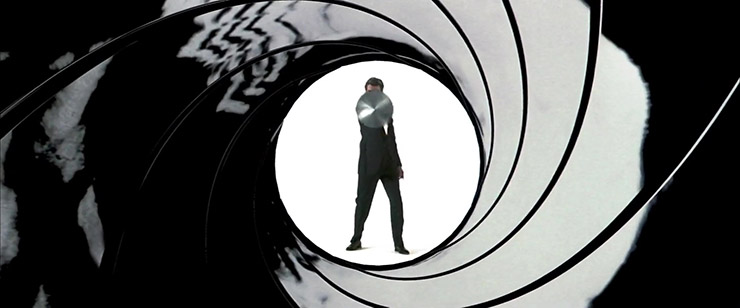 |
|||
|
PIERCE BROSNAN Die Another Day (2002) [with CGI bullet effect] |
|||
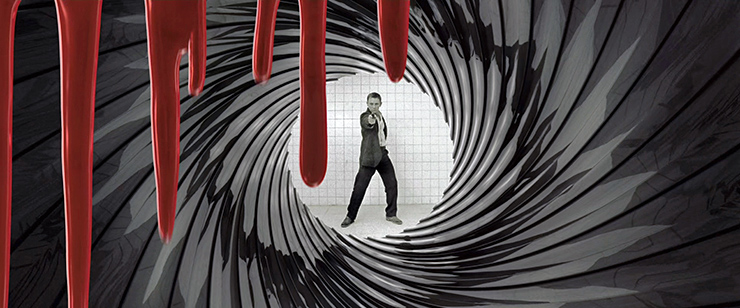 |
|||
|
DANIEL CRAIG Casino Royale (2006) [formed part of the main titles] |
|||
|
With the controversial casting of Daniel Craig as James Bond in 2005, the 007 series went back to basics with the origin story of how the character earned his licence to kill in Casino Royale (2006). Daniel Kleinman's new take on the gun barrel sequence is actually part of the main titles of the film (as it had been in Dr. No). The entire pre-credit sequence and gun barrel are in black & white, and the first colour seen in the film is the animated re-imagined dripping blood at the start of the main titles. |
|||
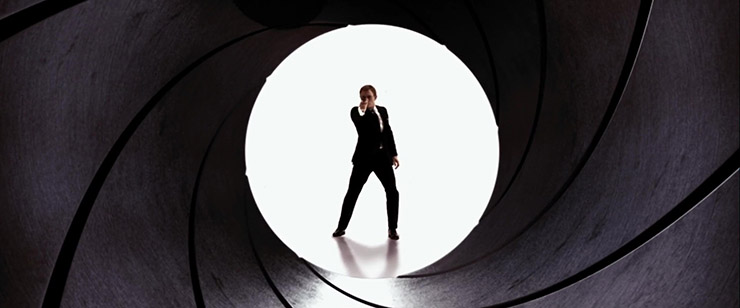 |
|||
|
DANIEL CRAIG Quantum of Solace (2008) [seen at the end of the film] |
|||
|
For Daniel Craig's second appearance as James Bond the main titles and gun barrel sequence were designed by MK12 - a Kansas based graphic design and filmmaking collective brought in by director Marc Forster. The gun barrel was re-filmed with Daniel Craig and controversially placed at the end of Quantum of Solace (2008). |
|||
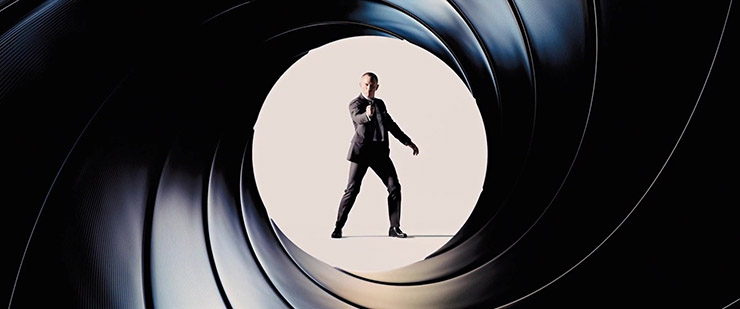 |
|||
|
DANIEL CRAIG Skyfall (2012) [seen at the end of the film] |
|||
|
Daniel Kleinman returned to the series with Skyfall (2012) that once again placed the gun barrel at the end of the film. Daniel Craig filmed his third walk that was composited into a new computer generated gun barrel, which like its predecessor no longer resembled the barrel seen in Maurice Binder's original design, and appeared more as a simple spiral, or camera iris effect as the motif is often incorrectly described. |
|||
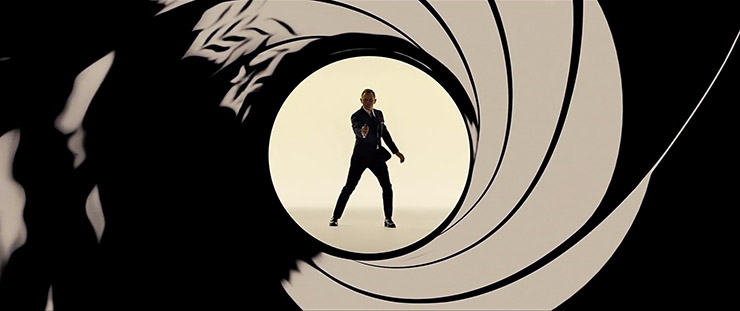 |
|||
|
DANIEL CRAIG Spectre (2015) |
|||
|
The gun barrel was finally returned to its rightful place at the start of Spectre (2015), and Daniel Kleinman created a more traditional-looking graphic with Daniel Craig re-filming the sequence for a fourth time. |
|||
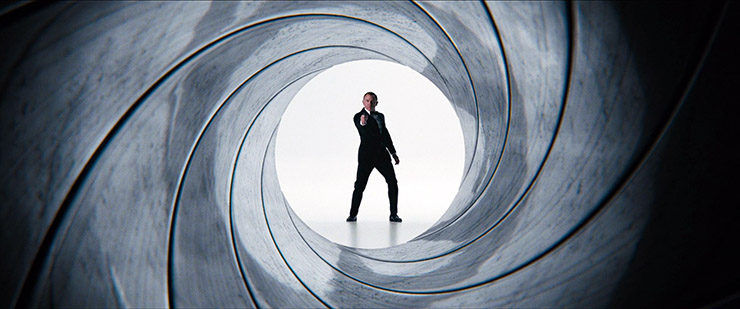 |
|||
|
DANIEL CRAIG No Time To Die (2021) |
|||
|
For Daniel Craig's final James Bond film, No Time To Die (2021), his gun barrel sequence was filmed for a fifth time; this time with the motif changed to an ice-blue hue reflecting the opening shots that follow it. For the first time in the series there is no blood dripping down the screen and Bond fades away after firing his gun, a notion that many have interpreted as foreshadowing the ending of the film. No Time To Die was the first film in the series to be distributed by Universal Pictures, who had the screening rights outside the USA. Therefore, those territories saw an alternate version of the gun barrel where the opening was amended to have the Universal logo appear after the MGM logo, and then shrink to become one of the initial white dots which then exits screen left. The familiar white dots accompanied by Monty Norman's ‘The James Bond Theme’ then appear as usual, and it was this version seen in the USA, and later when the film was released to online streaming platforms. |
|||
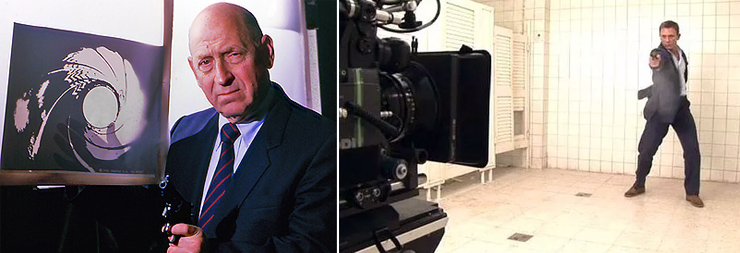 |
|||
|
Despite shooting numerous versions of the gun barrel throughout his James Bond career, graphic designer Maurice Binder maintained that it was the original version he preferred. Speaking to Starlog magazine in 1983 he said “The first gun barrel shot was much better than it is now,” Binder states, with slight chagrin. “I don't know why, but that first one for Dr. No had the gun's beautiful, striated insides which were absolutely magnificent. We even picked up the bleed from the red when the blood came down the screen, which gave it all a silver-sepia look.” After 60 years, 25 instalments and 6 James Bond actors, the gun barrel sequence is the one constant that has appeared in every film in some form or another. It is a testament to the talent and imagination of Maurice Binder who created the original motif back in 1962, that the image is instantly recognisable and forever emblematic of the most successful film series in history. |
|||
| JAMES BOND NEWS | |||